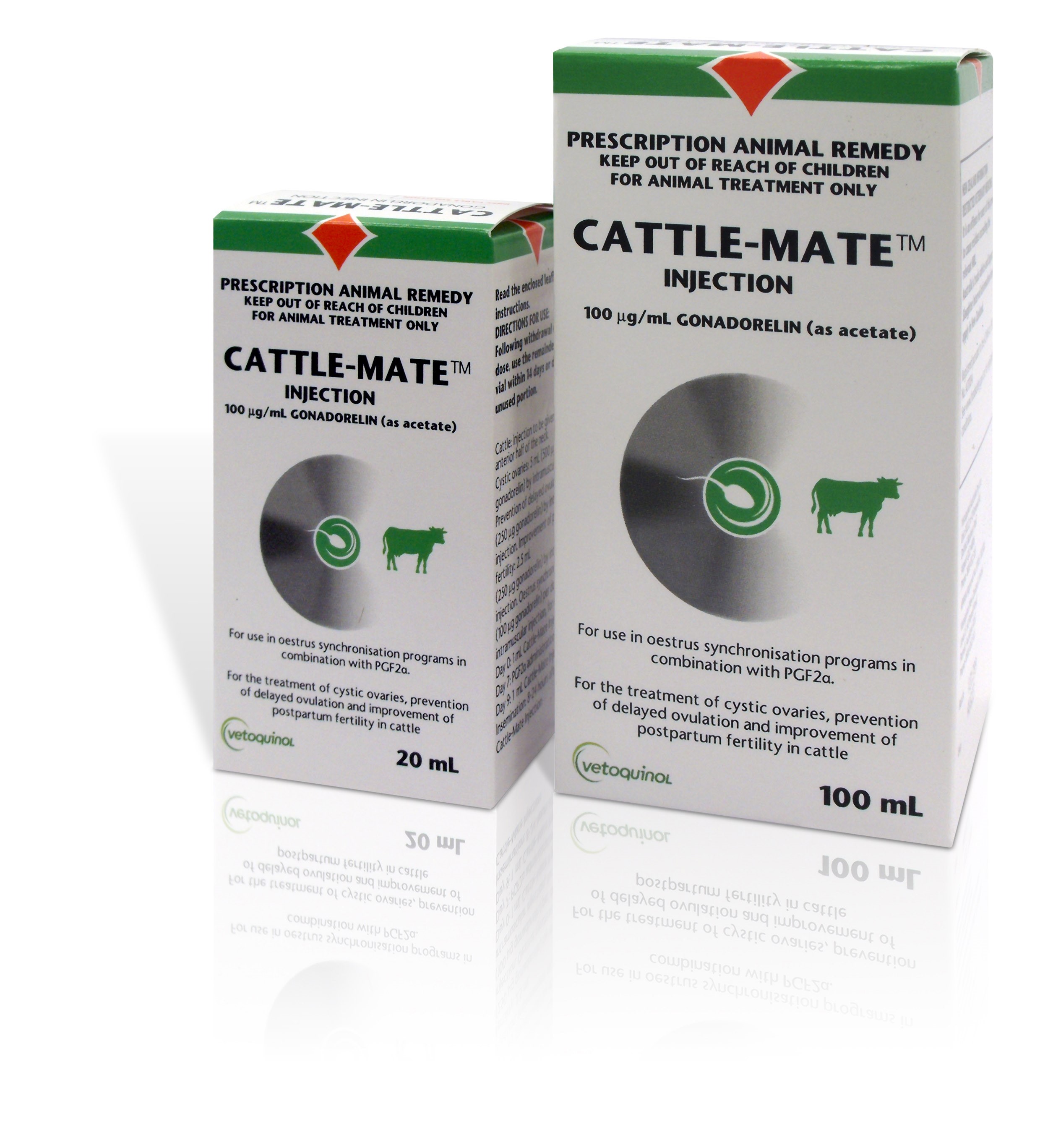
Cattle-Mate™ Injection


 Oestrus synchronisation protocols involving the use of Prostaglandin F2α (PGF2α) and Gonadotrophin Releasing Hormone (GnRH) have been subjected to extensive study in dairy herds around the world.
Oestrus synchronisation protocols involving the use of Prostaglandin F2α (PGF2α) and Gonadotrophin Releasing Hormone (GnRH) have been subjected to extensive study in dairy herds around the world.
Gonadorelin is a synthetic decapeptide, identical to the endogenous GnRH. GnRH is synthesised and secreted in a pulsatile manner by the hypothalamus and is transported via the hypothalamichypophyseal portal circulation to its site of action, the anterior pituitary.
Gonadorelin induces the synthesis and release of gonadotrophins from the anterior pituitary, such that LH and FSH are released from the pituitary shortly after gonadorelin administration. LH and FSH act on the ovary to stimulate maturation of ovarian follicles and ovulation.
or discard the unused portion.
Cattle: Injection to be given into the anterior half of the neck.
Cystic ovaries: 5 mL (500 μg gonadorelin) by intramuscular injection.
Prevention of delayed ovulation: 2.5 mL (250 μg gonadorelin) by intramuscular injection.
Improvement of postpartum fertility: 2.5mL (250 μg gonadorelin) by intramuscular injection.
Oestrus synchronisation: 1 mL (100 μg gonadorelin) per dose by intramuscular injection, for example:
Day 0: 1 mL Cattle-Mate Injection
Day 7: 2 mL PGF2a
Day 9: 1 mL Cattle-Mate Injection
Oestrus synchronisation
Oestrus synchronisation protocols involving the use of Prostaglandin F2a (PGF2a) and Gonadotrophin Releasing Hormone (GnRH) have been subjected to extensive study in dairy herds around the world. Comparisons have been made between GnRH/PGF2a synchronisation programs and a variety of existing reproductive management programs of varying levels of intervention. GnRH/PGF2a protocols have measured favourably against standard prostaglandin programs in terms of reproductive
parameters such as pregnancy rate and calving to contraception interval.
Unlike previously implemented synchronisation protocols utilising PGF2a only, application of the GnRH/PGF2a protocol described below results in synchronisation of ovulation to a degree of precision that allows fixed-time insemination.
A reproductive program using fixed-time insemination provides numerous benefits both in terms of reduced management input and economic advantages. Fixed-time insemination reduces management input through the insemination of large groups of cows together, and by elimination of the need for oestrus detection activities in the first round. The benefits are magnified in situations where the level of oestrus detection is low. Economic benefits of a fixed-time insemination program result from a
reduction in calving to conception interval and a tighter calving pattern, parameters of particular significance under seasonal calving conditions. GnRH/PGF2a protocols have the added advantage of demonstrated success for simultaneous treatment and synchronisation of cows suffering from cystic ovarian disease, and the ability to stimulate and synchronise the oestrus cycle of previously anovulatory cows.
The GnRH/PGF2a protocol that has received the most interest and study for its applicability to dairy cattle reproductive management may be summarised as follows:
Day 0: GnRH administration
Day 7: PGF2a administration
Day 9: GnRH administration (48 hours after PGF2a)
Insemination: 8-24 hours after second GnRH.
Insemination is performed at a fixed time 8 to 24 hours after the second GnRH dose, regardless of presence or absence of visible oestrus.
Treatment of cystic ovaries
Cystic ovaries are an important infertility problem in dairy cattle. Ovarian cysts may be single or multiple, and of follicular or luteal origin. Clinical signs of ovarian cysts include irregular oestrus cycles, anoestrus and nymphomania. Diagnosis of ovarian cysts is by rectal palpation of the structures on one or both ovaries.
Ovarian cysts respond to the LH release induced by treatment with Cattle-Mate Gonadorelin Injection, such that normal cyclical activity may resume.
Prevention of delayed ovulation
Delayed ovulation can result in reduced conception rates due to asynchrony between ova and sperm at the time of artificial insemination (AI). Administration of CATTLE-MATE INJECTION during the first 40 days of the postpartum period may initiate a resumption of cyclicity in acyclic cows, and reducethe incidence of postpartum ovarian disorders.




